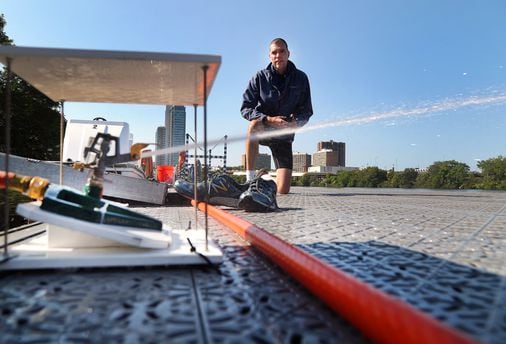But for several months now, the docks at the Riverside club, a nonprofit with about 300 members, have been almost entirely free of goose poop. That makes launching the club’s one- to eight-person shells a simpler and vastly more pleasant operation, particularly in the predawn darkness when many rowers prefer to exercise.
“It’s a game changer,” Lynn Osborn, a 42-year club member and past president, remarked to a reporter on her way in from an early row on a misty September morning. “Used to be the first thing you’d have to do was clean your spot.”
Roy, who first took up rowing in college at Boston University in the 1980s, said the idea for an automated system to scare off the geese came to him while gabbing with friends at the Dunkin on Memorial Drive. Complaining about goose poop on the docks was a recurring topic.
A devoted tinkerer, Roy said one of the inspirations came from the Greg Kinnear movie “Flash of Genius,” about the true story of the invention of the intermittent windshield wiper. “I was thinking that the pieces are all out there,” the 59-year-old said. “It’s how you combine them.”
A couple of years ago, one of the members of Roy’s rowing club had installed motion activated sprinklers. If a goose hopped on the dock at night, the sensors triggered the sprinklers to chase the birds away with strong jets of water. But rowers didn’t like getting sprayed during the day and ended up covering the sprinklers with 5-gallon buckets. “People would forget to uncover them in the evening,” Roy said. “It just didn’t work.”
Roy recalled that during his career as a biomedical engineer he once ginned up a facial recognition app to help him learn the names of new employees. He thought he could apply this kind of solution to the goose problem. So he replaced the motion activated sprinklers with cheap lawn sprinklers and cameras mounted on the second floor of the boathouse facing the docks.
The cameras snap still images every few seconds and an app on a connected Raspberry Pi computer looks for signs of motion. If the app detects motion in a photo, the image is uploaded to Amazon Web Services where one of the cloud computing giant’s AI image recognition programs figures out the source of the motion.
If the source was a person or a dog, or even other kinds of birds, the app does nothing (a rower dressed in black and white was once misidentified as a penguin). But if the source was a goose, the app orders up a second picture to be sure and then alerts the system to set off the sprinklers. The cloud service costs fractions of a cent per photo analyzed, and running the whole system for a month costs only about $20, Roy said.
The geese have largely gotten the message. They’ll sometimes tempt the system by hopping up on the docks, but as soon as the birds hear the lawn sprinkler’s unmistakable chucka-chucka-chucka sound, they depart before getting sprayed. Lately, Roy said the geese have even tried swimming around the dock and hopping on from the back side, but that still triggered the sprinklers.
Demonstrating the system on a predawn morning along the river, Roy looked every bit the rower himself at 6′4″ and skinny as a rail, wearing a “Head of the Charles” volunteer windbreaker. “That thing is so cool,” a rower putting his boat away and pointing at the sprinklers called over to Roy.
Because of the Migratory Bird Act of 1918, it is illegal to harm the geese but harassing them with water is allowed. It’s a more effective tactic than trying to scare the birds off with sounds or fake predators, Wes Anderson, an assistant professor of wildlife at Auburn University, said.
“Over time, geese and other nuisance wildlife can become accustomed to those sights or sounds and learn they are not actually a threat,” Anderson said. “This is much less likely to occur with water as the deterrent, making direct physical, albeit harmless, contact.”
Roy said he’s fielding inquiries from other rowing clubs with geese overrunning their docks. “You’re not allowed to harm these animals so we have to learn how to coexist with them,” Roy said. “We have to outsmart them.”


